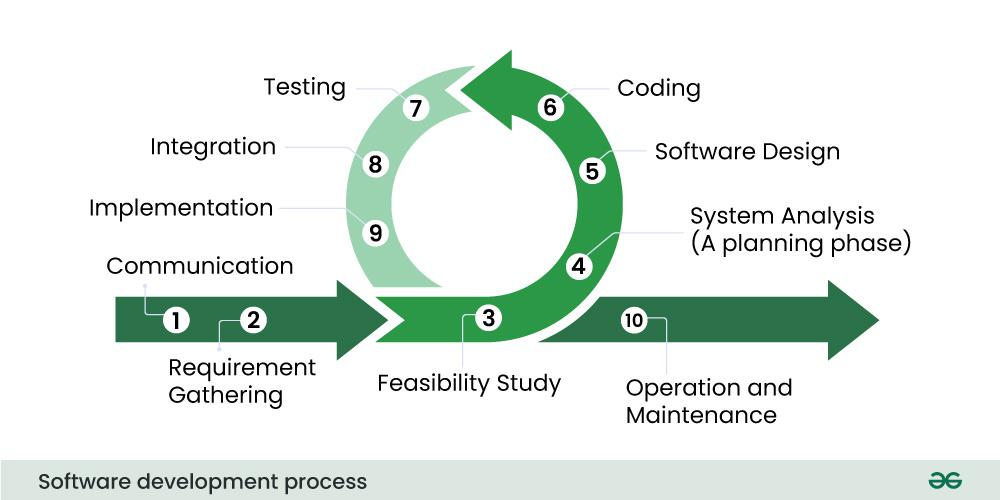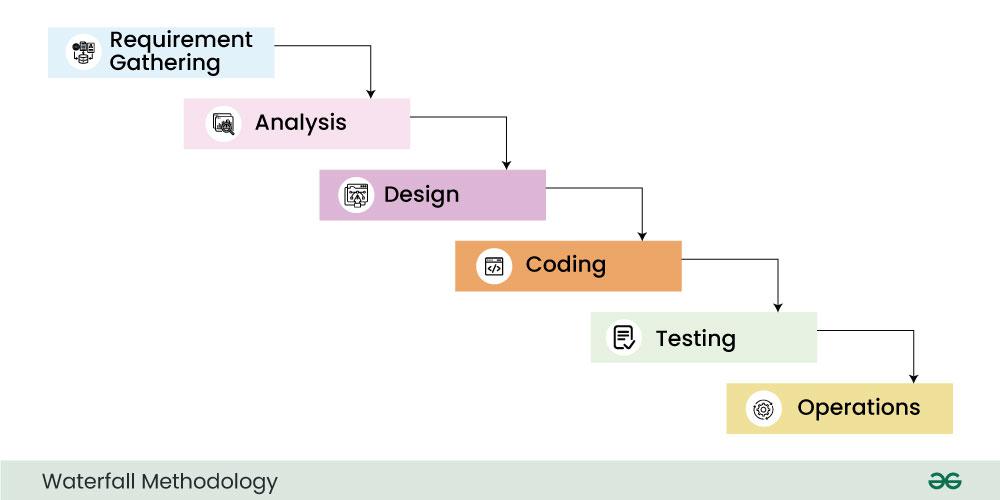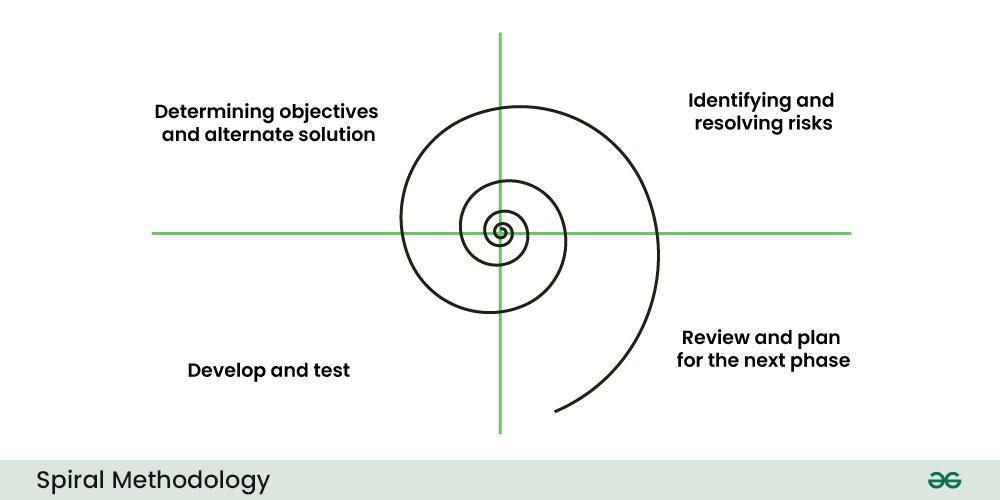The software development process is nothing but the process of developing software. This process might include improving design and product management by splitting the work into smaller steps or processes.
Software is nothing but a set of programs having specific functions that are designed to work according to human needs. The Software Development Process includes different steps in an organized way to form a software product. In this article, we are going to learn about Software Development Process, their needs, the purpose of the software development process, steps of the software development process, approaches of Software Development, and types of software development process.
.webp)
Software Development Process
What is Software Development Process?
The software development process is nothing but the process of developing software. This process might include improving design and product management by splitting the work into smaller steps or processes.
What are the 10 Software Development Processess?

Software Developement Process
The software development process is the sequence of activities that leads to the production of a software product. The steps of software development process are as follows:
1. Communication
The first and foremost step is where the user contacts the service provider i.e. software organization and initiates the request for a desired software product. The software organization talks with the customer about its requirement and then work according to its needs.
In this step, the team of software developers holds discussions with various stakeholders from the problem domain and provides as much as information possible for the requirement of the software product. The requirements can be of different forms like user requirements, system requirements, functional requirements, etc.
3. Feasibility Study
After requirement gathering, with the help of many algorithms, the team analyzes that if the software can be designed to fulfil all requirements of the user and also analyzes if the project is financially, practically and technologically feasible for the organization or not.
4. System Analysis(A planning phase)
Software developer decides on a roadmap for their plan and tries to bring up the best software model stable for the project. System analysis may also include understanding product limitations and identifying and addressing the impact of the project on the organization. The project analyzes the scope of the project and plans the resources accordingly.
5. Software Design
Software design whole knowledge of requirements and analyses are taken together to plan up design of software products. It takes input from the user and information gathered in the requirement-gathering phase. It gives output in the form of logical and physical design.
6. Coding
This step is also known as the programming phase. The implementation of software design starts in the form of writing code in suitable programming and developing error-free programs efficiently.
7. Testing
Software testing is done while coding by the testers’ developing team members. Testing is done at various levels i.e. module testing, product testing, program testing and user-end testing.
8. Integration
After writing all the codes for the software such as frontend, backend, and databases, The software is integrated with libraries, databases and other programs.
9. Implementation
In this step, the software product is finally ready to be installed on the user’s machine. Software is tested for profitability, integration, adaptability, etc.
10. Operation and Maintenance
This phase confirms the software operations in terms of more efficiency and fewer errors. If required, the users are trained or aided with the documentation on how to operate the software and how they keep the software operational. This software is maintained timely by updating the code according to the changes taking place in the user and environment or technology.
Need for Software Development Process
A software development process is needed as it creates software in an organized manner. It is used to ensure that whether the project is delivered on time or not. It also examines the project’s and the customer’s requirements. The technique also allows for iterative testing and improvement, which can aid in detecting and correcting problems early on. There are several reasons why we require a software development process. Let’s see some of them.
- Meeting Requirements: The software development process ensures that the final product meets the specified requirements that are needed by the customer.
- Timely Delivery: Following a software development process helps in managing project timelines effectively. It checks whether a project is delivered on time or not.
- Budget Control: The software development process facilitates budget control by allowing for better estimation and tracking of resources and costs.
- Quality Assurance: The process includes testing and quality assurance activities, enabling the identification and resolution of bugs, defects, and usability issues.
Purpose of Software Development Process
The main purpose of SDP is nothing but to ensure a quality product that is delivered to the end customer. It’s a series of steps that make sure everything meets the required specifications, is easy to maintain and scale, and is delivered on time while not breaking the bank. The main goal of the software development process is to give value to users and meet their needs. Software-making organizations try to reduce the risk of project failure, increase productivity, and improve their software quality by following an organized development process.
The Purpose of software development process is to develop the software as quickly as possible while taking care of quality and security. Following are the main purpose of software development process:
- Organization and Structure: A development process provides a framework for organizing tasks and activities involved in software development. It defines roles, responsibilities, and communication channels within a development team.
- Quality Assurance: The process involves quality assurance and testing stages that ensure that the software fulfills the specifications, is defect-free, and performs as expected.
- Risk Management: A well-defined process helps in the early identification of potential risks and provides tools for controlling and reducing those risks.
- Efficiency and Productivity: By following a process, development teams can improve efficiency and productivity
- Communication and Collaboration: A software development process provides communication and collaboration among team members, stakeholders, and other relevant parties.
Approaches of Software Development
Software development approaches are nothing but the methodologies that are used to organize and plan the process of building software. There are various approaches, including Agile, Waterfall, Iterative, and V-Model, each with its own set of practices and principles. Let us understand in detail.
Waterfall Approach
Waterfall Approach is one of traditional methods which consist of a popular classic approach and it is also a popular version of the software development lifecycle in the field of software engineering.
Advantages of Waterfall Approach
- Waterfall methodology can easily manage small projects and has a separate review process.
- In waterfall methodology it consists of separate development stages deadlines.
Disadvantages of Waterfall Approach
- Waterfall methodology is not applied for the projects which need modifications on the way.

Waterfall Approach
Spiral Approach
Spiral methodology is a lifecycle model which is highly sophisticated and it functions by the early identifications and the reduction of the risks in a project. Spiral methodology makes sure that the software developers can make necessary changes in the design or in the code in the testing stage.
Advantages of Spiral Approach
- Spiral methodology involves large risk analysis which further leads to less risks.
- The main advantage of the spiral model is that required changes can be made even in the last testing stage.
Disadvantage of Spiral Approach
- Spiral methodology is a complete waste of resources for the projects which consists of low risks factors.

Spiral Approach
Incremental Approach
This model works on putting design first (as it takes less time) for both planning and analyzing which also makes it one of the best methods when it comes to cost saving. This method is popular because of its adaptability, it allows teams to implement requirements without any prior planning and developers can work on creating new versions in no time and further updates can be provided using this methodology.
Advantages of Incremental Approach
- The incremental approach allows for the early delivery of partial functionality. Users can begin using and experiencing some features earlier than in a standard waterfall approach.
- It reduces the risk of project failure.
Disadvantage of Incremental Approach
- Since the software is developed incrementally, the full system may not be available until later in the development cycle.
Agile is nothing but a software development approach that focuses on flexibility, collaboration, and delivering working software in iterative cycles. Agile methodologies, such as Scrum and Kanban, prioritize close collaboration between team members, regular feedback loops, continuous improvement, and adaptability to change.
According to a recent survey by VersionOne, 87% of organizations use agile development for some or all of their software development projects.
Advantages of Agile Methodology
- Due to involvement of small iteration it delivers high quality of output.
- With the help of Agile methodology allows creative improvements whenever working on the software product.
- The agile methodology is popular for its minimal reliance and adaptivity on the initial documentation.
Disadvantages of Agile Methodology
- Agile methodology doesn’t consist of any deadlines.
- Agile methodology also lacks clarity and the project vision.

Agile Approach
Metrics of Software Development Process
Metrics are essential in software development to measure and improve the efficiency, quality, and progress of the development process. There are various metrics used in software development, and they can be categorized into different areas:
1. Productivity Metrics:
- Lines of Code (LOC): Measures the size of the codebase, but should not be used as the sole indicator of productivity.
- Function Points: Quantifies the functionality delivered by the software.
- Velocity: Commonly used in Agile methodologies, it measures the amount of work completed in a sprint or iteration.
2. Quality Metrics
- Defect Density: The number of defects or bugs per unit of code (e.g., per thousand lines of code).
- Code Review Feedback Time: The time it takes to address feedback from code reviews.
- Code Churn: The frequency of code changes, which can indicate instability.
3. Efficiency Metrics
- Lead Time: The time from the inception of a software request to its delivery.
- Cycle Time: The time it takes to complete a single cycle or task, often used in Agile development.
- Throughput: The number of features or user stories completed in a given time frame.
4. Customer Satisfaction Metrics:
- Net Promoter Score (NPS): Measures customer satisfaction and likelihood to recommend the software.
- Customer Support Response Time: How quickly customer support responds to and resolves issues.
5. Codebase Metrics
- Code Complexity: Metrics like cyclomatic complexity or maintainability index assess code quality.
- Code Coverage: Estimates the proportion of code that is covered by automated testing.
- Technical Debt: Quantifies the amount of suboptimal code that needs to be addressed in the future.
6. Team Metrics
- Team Velocity: The team’s average output over a period, useful in Agile.
- Team Satisfaction: Surveys or feedback mechanisms to gauge the team’s morale and engagement.
FAQs on Software Development Process
1. What is the Software Development Process?
The software development process is nothing but the process of developing software. In this process, the software developer is required to perform some steps to design software.
2. What are the steps included in the Software Development Process?
The steps included in the Software Development Process are Communication, requirement gathering, Feasibility Study, System Analysis, Software Design, Coding, Testing, Integration, Implementation and Operation and Maintenance.
3. What is the need for the software development process?
A software development process is needed as it creates software in an organized manner.
4. What is the purpose of requirements gathering in software development?
Requirements gathering is nothing but the process of collecting the functional and non-functional requirements of a software project. The main motive of this step is to collect all the requirements from the user.
Share your thoughts in the comments
Please Login to comment...